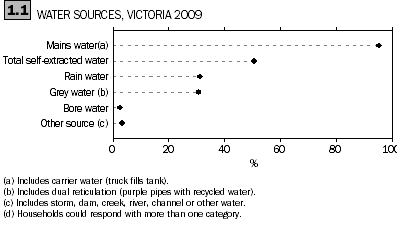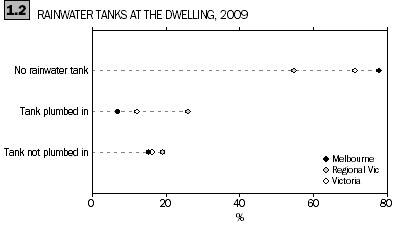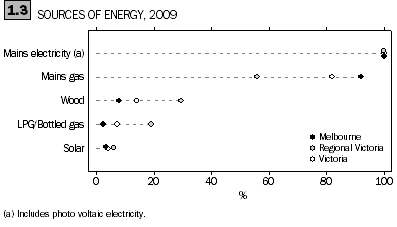 WATER AND ENERGY SOURCES
WATER AND ENERGY SOURCES
This chapter explores Victorian household water and energy sources.
Recent government policies have focused on alternative sources of household water and energy, to (in turn) reduce reliance on traditional sources. In 2009, the federal government implemented the Renewable Energy Target Scheme, which is designed to ensure that 20% of Australia’s electricity supply will come from renewable sources by 2020 (DCCEE 2010).
Both federal and state governments offer various programs reducing the household's costs of installing alternative water and energy sources, such as grants for solar panels, rainwater tanks or grey water systems. Since 1999, the proportion of Victorian households with environmentally sustainable alternative sources such as rain water tanks and solar panels has been increasing, reflecting trends observed nationally (ABS 2007; ABS 2008). In addition, since 2005 all new Victorian residential homes must meet a minimum 5-star energy efficiency and water saving rating, including the options of installing either a solar hot water service or rain water tank.
The Victorian Government is currently expanding Victoria's mains water grid by building new connections and pipelines to enable water to be moved where it is needed. Mains gas, while not as extensively available as mains water and electricity, is accessible across large sections of Victoria, including Melbourne, south-western Victoria, central northern Victoria and parts of East Gippsland.
WATER SOURCES

Nearly all Victorian households (1,994,200) were connected to mains water. In Melbourne, 1,492,300 households (99%) were connected to mains water while in regional Victoria 501,900 households (86%) had mains water.
More than half (51%) used self-extracted water sources, mainly consisting of rain water (655,400 households) and grey water (642,000 households). Self-extracted water is water extracted directly from the environment for use (including rivers, lakes, groundwater and other water bodies). Some of this water is then distributed via a water provider to others.
Households in regional Victoria had a higher proportion of self-extracted water, with 66% of households using that source of water, when compared to Melbourne at 45% (388,600 households). The Loddon-Mallee Statistical Region (SR) in central Victoria had a higher rate of households (82%) with self-extracted water.
In contrast, Inner Melbourne SR, which contains the Melbourne CBD and inner city, had much lower rates of self-extracted water, with just 14% of households.
While Melbourne had similar rates of grey water and rain water making up total self-extracted water, regional Victoria had a higher rate of rain water (46%) than grey water (36%).
Across Victoria, households with self-extracted water were less common in rented dwellings (22%) than those being purchased (58%) or owned outright (65%). In terms of dwelling age, dwellings more than two years old had a higher rate (51%) of self-extracted water than newer dwellings (48%).
In regional Victoria, fewer households had self-extracted water if household income was less than $25,000 per year (59%) compared to households with household income $110,000 or more per year (72%). Across Victoria, households with the highest incomes had a slightly higher proportion of rain water (33%) than those with the lowest incomes (26%).

Of the 600,100 Victorian households with a rainwater tank, a greater proportion of households in regional Victoria (46%) had rainwater tanks than Melbourne (22%). Across Victoria, 31% of households with the highest incomes ($110,000 or more per year) had a rainwater tank compared to 23% of the lowest income households (less than $25,000 per year).
Households without a rainwater tank in Melbourne were more commonly rented dwellings. Most rental properties in Melbourne did not have a tank (95%) but the proportion was lower in regional Victoria where a smaller majority of rented dwellings (81%) did not have a tank.
For Victoria, 257,700 households with a rainwater tank had it plumbed into the dwelling. Households in regional Victoria were more likely to have a tank plumbed into their dwelling across all tenure types. Only 7.7% of households owned outright were plumbed in across Melbourne, compared to 33% plumbed in across regional Victoria. For Victoria, almost twice as many dwellings two years old or less were likely to have rain water tanks plumbed in (25%) compared to dwellings over two years old (12%) and was also apparent for Melbourne where 22% of dwellings two years old or less had a rain water tank plumbed in compared to only 6.2% of dwellings over two years old.
ENERGY SOURCES

All households in Victoria had mains electricity and 1,711,500 households (82%) also had mains gas. Melbourne had a higher overall rate of households with mains gas at 92%, but both rented dwellings and semi-detached dwellings, flats, units or apartments showed a lower proportion of mains gas at 87% and 84% respectively.
Across Victoria 151,500 households used LPG/bottled gas. A lower rate of mains gas in households in regional Victoria may be complimented by a higher rate of LPG/bottled gas. For regional Victoria, 19% of households had LPG/bottled gas compared to 2.5% in Melbourne. At 2.9%, rented households had a lower proportion with LPG/bottled gas across Victoria than dwellings being purchased (9.1%) or dwellings owned outright (8.6%).
295,400 Victorian households used wood as a source of energy for purposes such as heating and cooking, but it was less common in Melbourne. Only 3.4% of the lowest household income earners (less than $25,000 per year) used wood compared to 12% of the highest income earners ($110,000 or more per year). Rented households were less likely to use wood as an energy source, with only 4.5% stating they used it in Victoria.
89,400 households used solar as a source of energy in Victoria. A larger proportion of dwellings two years old or less (18%) had solar energy than older dwellings (3.8%). 7.4% of households with a household income of $110,000 or more per year had solar energy compared to 1.8% of households with the lowest income.
For the purposes of the survey, solar energy was recorded differently from photovoltaic energy. Solar energy absorbs sunlight into water carrying tubes ('Solar' category within data cubes) as differentiated from photovoltaic energy which converts sunlight directly into electricity (included as part of 'Mains electricity' within data cubes).
References
ABS (Australian Bureau of Statistics) 2007, Environmental Issues: People's Views and Practices, Mar 2007, Cat no. 4602.0, ABS, Canberra.
ABS 2008, Australia's Environment: Issues and Trends, Jan 2010, Cat no. 4613.0, ABS, Canberra.
DCCEE (Australian Government Department of Climate Change and Energy Efficiency) 2010, ‘Renewable Energy Target’, Department of Climate Change and Energy Efficiency, online, http://www.climatechange.gov.au/government/initiatives/renewable-target.aspx, last viewed 16 June 2010.
 Print Page
Print Page
 Print All
Print All
 Print Page
Print Page
 Print All
Print All